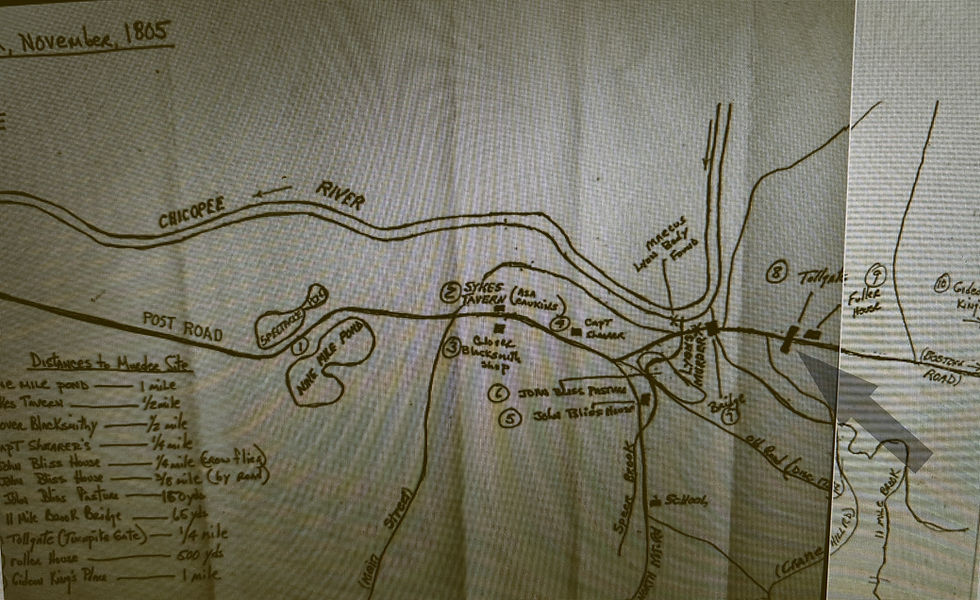The Rumors of Captain Kidd's Gold
- David Bourcier
- Jun 13
- 3 min read
Updated: 3 days ago
Around 1850, persistent rumors circulated in numerous New England towns suggesting that portions of "Captain Kidd's gold" lay buried within their borders. In Wilbraham during this era, one particular individual harbored a firm belief or perhaps a fantastical dream that some of this legendary treasure was concealed atop our local mountain. Specifically, he envisioned its presence within an ancient cellar hole situated on the eastern slope of Ridge Road, just north of the present-day intersection with Monson Road.
Captain William Kidd (c. 1645-1701) was a Scottish privateer turned pirate who gained legendary status despite capturing only one significant prize ship. Persistent rumors suggest he buried a vast treasure that remains undiscovered. Kidd's downfall began with his arrest in Boston in July 1699 and continued when he was brought to England in April 1700. In 1701, he met his end at Wapping Old Stairs, located on the southern bank of the Thames, beyond London Bridge and the Tower of London, at the infamous Execution Dock.
Pirates meeting their grisly fate at Execution Dock faced an unsettling end. The gallows there were infamous for employing a short drop method, which meant that the condemned pirates were not killed instantly by a broken neck, but instead slowly strangled. This caused their bodies to convulse and twitch, giving the appearance of a macabre dance as they died.
Captain William Kidd, one of the most infamous pirates of his time, met his end in this manner in 1701. His body was gibbeted and left suspended in the Thames estuary for three years, serving as a haunting symbol of the consequences of this crime during the Golden Age of Piracy.
Before he arrived in Boston, Captain William Kidd took precautions to bury his stolen treasure, with potential locations including New Jersey, Long Island, and Gardiners Island. Under pressure from authorities in Boston, Kidd disclosed some of these hiding spots. He was compelled to provide a detailed inventory of his loot, which survives as a historical document today. Among the recovered items listed were silver ingots, gold coins, jewels, bales of silk, and substantial quantities of iron and sugar.
Despite this disclosure, a legend persisted that Kidd had not revealed all of his treasure. It was believed that another cache, possibly larger than the recovered loot, remained hidden somewhere. This tantalizing legend fueled centuries of treasure-hunting endeavors in locations remotely associated with Captain Kidd, all without success. The speculation about the treasure's whereabouts ranged from the eastern coast of America to as far as India.
While the actual existence of undiscovered treasure remains a mystery, Kidd's penchant for burying loot has firmly entrenched itself in pirate folklore and fiction. His story and the search for his hidden treasure have become integral parts of pirate tales and continue to capture imaginations to this day.
Others in Wilbraham during the 1850s became intrigued by the rumors of Captain Kidd's buried gold, prompting them to embark on nocturnal expeditions to the site. Night after night, they diligently dug into the earth around the old cellar, hoping to uncover the hidden treasure. According to local belief, absolute silence was crucial during these excavations. It was feared that if the iron case containing the gold was unearthed and the tranquility of the night was disturbed by a human voice, the treasure would mysteriously vanish, sinking deep into the mountain's depths beyond reach.
Among the curious onlookers was a young boy, aged about eight or ten years old, eager to unravel the mystery like many boys his age. He stealthily followed the men with their picks and shovels from his home late in the evening to the deserted cellar, maintaining a cautious distance to observe their activities unnoticed. Remarkably, he survived the eerie experience and later recounted the incident to Chauncey Peck, the author of the 1913 History of Wilbraham.
During the time of Captain Kidd, the area now known as Wilbraham was referred to as the Outward Commons, predominantly known as Springfield Mountain. This region was largely wilderness and remained unsettled at that time. The only road in the area was the Bay Path, which connected the settlement of Springfield to the town of Boston. The rumored location of Kidd's treasure was approximately two miles south of this road, along the ridge of the mountain. It is highly unlikely that Captain Kidd hid any treasure there, especially considering that the supposed old foundation where the treasure was hidden likely did not exist during his era. However, this notion makes for an intriguing fictional story about Captain Kidd and his hidden plunder.





Comments